Randy Ellefson's Blog, page 27
November 5, 2018
Why Rain Shadows Cause Deserts
Mountains cause moisture-carrying winds to rise. The clouds dump all the rain on one side of the mountain range, causing lush vegetation. On the mountain range’s other side, there’s no water left to fall. This causes a “rain shadow,” an area that receives little to no rainfall. Deserts are the usual result. This process plays out across the Earth. A large list of examples can be found here: http://www.artofworldbuilding.com/rainshadow.
Rain shadows often occur near a coast and can cover half a continent, such as in the United States. Desert-like conditions occur closest to the mountains, though this is less severe farther from the mountains that are causing the rain shadow, partly because moisture doesn’t come exclusively from the oceans and will be picked up in the atmosphere to fall as rain (albeit less of it). As we progress farther from the mountains, desert may give way to grasslands and finally forests.
The post Why Rain Shadows Cause Deserts appeared first on The Art of World Building.
November 1, 2018
Understanding Prevailing Winds
Wind direction varies at different latitudes (distances from the equator). These winds, along with geography like mountains, will determine where rain falls. This affects both climate and where vegetation and deserts are. Understanding this helps world builders create sensible topography.
If our planet is tidally locked to the sun, it won’t rotate, one side burning and the other freezing. This extreme is not covered by this book, so we will assume our planet is rotating. On Earth, this rotation causes winds near the equator to travel east in the tropics, while winds in the temperate zones travel west. In the polar zones, winds are again eastward but are light. Technically, the westerly winds are not entirely westerly, as they move from near the equator toward the poles. Similarly, the easterly trade winds move toward the equator, not just easterly. Our invented planet can be rotating in the other direction, reversing these winds.
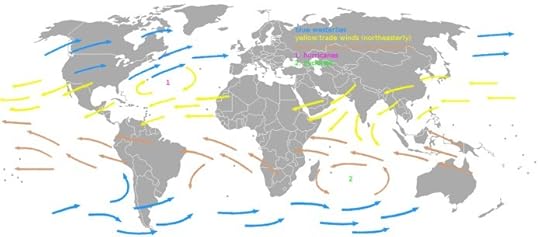
Figure 17 Prevailing Winds
A continent situated in the northern hemisphere like the United States or Europe will have westerly prevailing winds, which are called the westerlies for that reason. The easterly winds are called trade winds; sailors used them to cross the world’s oceans, expanding trade. Ships benefit from sailing in the direction of the wind (prior to the invention of engines). We can call these winds what we want in our world, but it may only come up in the context of ship-oriented stories.
In areas with light winds, factors such as mountains, valley breezes, or the difference in air pressure between sea and land breezes affect wind patterns. These are local phenomenon and not something to consider when creating land features.
The post Understanding Prevailing Winds appeared first on The Art of World Building.
October 29, 2018
Understanding the Tropical Zones
Extending north and south from the equator to roughly 23.5° latitude is a region called the tropics. This area is not defined by latitude but by the point at which the sun appears to be directly overhead at its highest point in the day, which is affected by the planet’s axial tilt. Since our imaginary planet can have a different axis than Earth’s, and therefore a different tropical zone, we can invent the area that is our tropical zone. Most of us will want to assume 23.5°, never mention this, and be done.
On Earth, the northern tropic is called the Tropic of Cancer while the southern is the Tropic of Capricorn. We’ll want different names for ours. To make life easier on readers, it might be best to name a tropic after a prominent city located at 23.5°, though doing so requires having drawn latitude lines on a map. Or we can wing it. Stating that a map is not drawn to scale gives us some leeway to be inaccurate. Even on Earth, most people have no idea which tropic is which, where they end, or why they should care. Our readers won’t remember either unless we name the tropics by something they’re more likely to remember, like a prominent city or a kingdom in that tropical zone. The latter frees us from an exact location.
The tropics move heat from the equator toward the poles and are the primary influencer of climates on every continent. Ocean temperatures and mountain ranges further modify climate. A high-altitude area in a tropic zone might have a climate more like a temperate zone.
Subtropics
The subtropics are the next farthest region from the equator, from 23.5° to 40°. On Earth, many deserts are in this zone, which seldom sees a hard frost or snow, but tropical storms and hurricanes can deliver as much as half of a country’s rainfall.
Temperate Zones
In between the polar and subtropical zones, from 40° to 66° is the temperate zone, where most life on Earth exists. Coastal regions experience milder winters and summers than areas far inland, which experience a greater range in temperatures. Similarly, high altitude areas in this zone might have a climate more like a polar zone. The areas closest to the poles can be considered sub-temperate.
Polar Zones
The polar zones cover the north and south poles to 66° latitude and are largely covered in polar ice caps. There isn’t much we need to worry about that isn’t obvious. It’s only mentioned to contrast it with the other zones.
The post Understanding the Tropical Zones appeared first on The Art of World Building.
October 25, 2018
Understanding Zones
The zones on a planet impact climate and will be discussed below. They are summarized in this chart:

The exact latitude where a climate changes is not constant, as it can vary from continent to continent, so these numbers are generalizations and world builders can avoid worrying about getting it right. Besides, we’re inventing a planet. Who can argue with us?
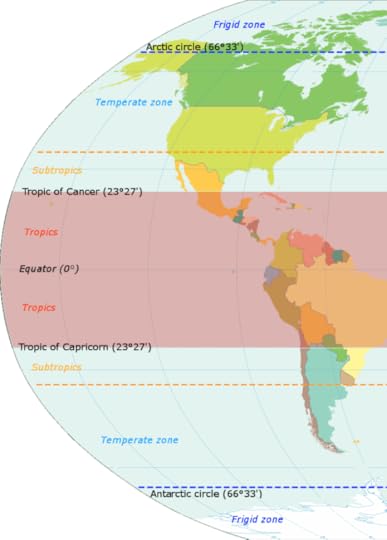
Figure 16 The Americas: Climate Zones
The post Understanding Zones appeared first on The Art of World Building.
October 22, 2018
Learn How the Ocean Affects Climate
Ocean currents play a major role in climate. Oceans absorb more of the sun’s radiation than the atmosphere, retaining and then distributing heat as the water flows around the planet. This effect is assisted by Earth’s rotation, salinity, and tides (which are in turn affected by the moon). If we have a world without significant oceans, this occurs less and the heat will be concentrated at the equator, leaving the poles more frigid. We can use this to create greater extremes between regions. For Earth-like worlds, we could ignore the ocean’s role unless we’d like to leverage it, but the effect on our work will be subtle and might not be worth the effort to some world builders.
For example, we could invent animals, plants, or species that are found on one coast but not another. Why? Because it happens on Earth. The Gulf Stream that runs along the eastern United States pulls warm water up the coast. The opposite happens on the western coast, where polar water comes south, resulting in much colder waters there. Most seal types prefer colder water and are found west but not east. This is turn means predators like great white sharks are also concentrated where the food is.
If we do this on our invented world, we could have someone from the west coast express disbelief that those around him are about to enter the water on the east coast. Aren’t they afraid to get eaten by a sea creature we’ve invented? They’d likely wonder what he’s talking about, as they don’t exist there. This depends on technological level, as the population of a more modern world like ours is more likely to be aware of differences even if not understanding the reason. In other words, this is arguably more likely in fantasy than in SF.
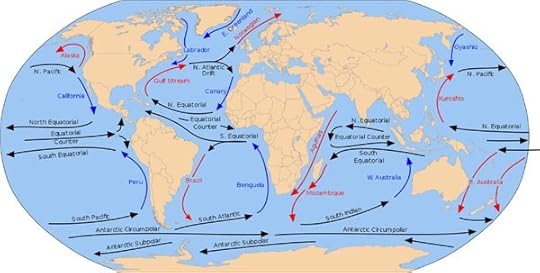
Figure 14 Ocean Currents on Earth
How do we determine where this might happen? According to NOAA (National Oceanic and Atmospheric Administration), “Major current systems typically flow clockwise in the northern hemisphere and counterclockwise in the southern hemisphere, in circular patterns that often trace the coastlines.” This means that a current is either carrying cold water from the pole toward the equator, or warm water from the equator toward the pole. On Earth, the western coasts are typically colder than the eastern ones. The online, color version of the above picture makes the difference in coastal temperatures easier to see, as the blue arrows are for cold water and are red for warm.
The details of this will depend on how many continents we have and their shape, but we needn’t go overboard and can just decide eastern coastal waters are warmer. A caveat here is that this all depends on the planet rotating in the same direction as Earth. If not, just reverse this.
So how does this affect climate? Warm coastal waters can moderate temperatures in one northern region relative to others, or conversely colder currents cause harsher winters. For example, parts of Norway have mild winters due to the Gulf Stream. We can note this in our files, but avoid explaining it in our stories, as explaining research we’ve done is among the worst, and most obvious, exposition errors.
The post Learn How the Ocean Affects Climate appeared first on The Art of World Building.
October 15, 2018
Learn How the Equator Affects Climate
The equator is an imaginary line equidistant from both poles. Days and nights there do not vary in length; this changes the farther from the equator we go. It’s perpetually hot except at high altitudes. The four seasons of spring, summer, autumn, and winter hardly exist. Instead, residents think of a dry season and a wet one, which averages two hundred days a year on Earth; some places are uniformly wet all year.
If we’re writing SF, the equator is a good place for space ports because the planet is spinning faster there and less fuel is needed to escape the atmosphere, though if we have imaginary propulsion systems, maybe fuel isn’t an issue. On Earth, spacecraft must launch easterly to take advantage of this spin. Imagine a scenario where one nation has limited fuel and wants to launch easterly, but the spacecraft must then go over an enemy nation capable of shooting it down. This illustrates how world building research affects a story.
When drawing a continent, we should decide where it lies in relation to the equator. Position impacts climate and the direction of prevailing winds, which carry moisture that is either blocked by mountain ranges or not; see the section on “rain shadows.” The location of deserts and forests (and what kind) are a direct result of this. The significance of position will be demonstrated by the rest of this chapter.
The post Learn How the Equator Affects Climate appeared first on The Art of World Building.
Learn How the Ocean Affects Climate
Ocean currents play a major role in climate. Oceans absorb more of the sun’s radiation than the atmosphere, retaining and then distributing heat as the water flows around the planet. This effect is assisted by Earth’s rotation, salinity, and tides (which are in turn affected by the moon). If we have a world without significant oceans, this occurs less and the heat will be concentrated at the equator, leaving the poles more frigid. We can use this to create greater extremes between regions. For Earth-like worlds, we could ignore the ocean’s role unless we’d like to leverage it, but the effect on our work will be subtle and might not be worth the effort to some world builders.
For example, we could invent animals, plants, or species that are found on one coast but not another. Why? Because it happens on Earth. The Gulf Stream that runs along the eastern United States pulls warm water up the coast. The opposite happens on the western coast, where polar water comes south, resulting in much colder waters there. Most seal types prefer colder water and are found west but not east. This is turn means predators like great white sharks are also concentrated where the food is.
If we do this on our invented world, we could have someone from the west coast express disbelief that those around him are about to enter the water on the east coast. Aren’t they afraid to get eaten by a sea creature we’ve invented? They’d likely wonder what he’s talking about, as they don’t exist there. This depends on technological level, as the population of a more modern world like ours is more likely to be aware of differences even if not understanding the reason. In other words, this is arguably more likely in fantasy than in SF.

Figure 14 Ocean Currents on Earth
How do we determine where this might happen? According to NOAA (National Oceanic and Atmospheric Administration), “Major current systems typically flow clockwise in the northern hemisphere and counterclockwise in the southern hemisphere, in circular patterns that often trace the coastlines.” This means that a current is either carrying cold water from the pole toward the equator, or warm water from the equator toward the pole. On Earth, the western coasts are typically colder than the eastern ones. The online, color version of the above picture makes the difference in coastal temperatures easier to see, as the blue arrows are for cold water and are red for warm.
The details of this will depend on how many continents we have and their shape, but we needn’t go overboard and can just decide eastern coastal waters are warmer. A caveat here is that this all depends on the planet rotating in the same direction as Earth. If not, just reverse this.
So how does this affect climate? Warm coastal waters can moderate temperatures in one northern region relative to others, or conversely colder currents cause harsher winters. For example, parts of Norway have mild winters due to the Gulf Stream. We can note this in our files, but avoid explaining it in our stories, as explaining research we’ve done is among the worst, and most obvious, exposition errors.
The post Learn How the Ocean Affects Climate appeared first on The Art of World Building.
October 11, 2018
Create Constellations
While many stars are visible in the night sky, only the brightest are likely to receive enough attention to be named. Names could be given by sailors or anyone else who watches the heavens. These stars are given significance, often heralding an important event, mostly because they were in the sky when something happened. Stars and constellations are not visible all year, for as the planet orbits, the stars overhead change. The same stars will appear each spring, for example. This is also apparent with constellations.
Constellations
Constellations are an area of world building that can be avoided until we need it. A constellation is a group of stars that suggest an outline of a person or object. They are often attributed mythological significance. In a fantasy setting, people may still believe in such things. In a SF setting, the beliefs may no longer be held true but the constellations may still be recognized. The visible constellations change with the season due to a planet’s orbit around its sun.
Creating constellations that matter to our characters can be done quickly. If we’ve invented gods or other world figures, like those discussed in Creating Life (The Art of World Building, #1), we can use them here. Deities, or objects they possess, such as Thor’s hammer, might be associated with a constellation. Mundane items might also be constellations, like our Big Dipper. People see familiarity and therefore comfort in the stars, and we have great freedom to do as we like.
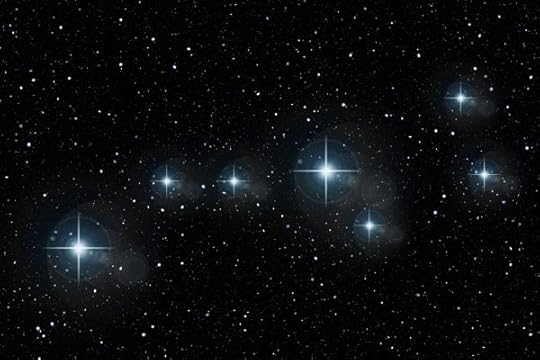
Figure 12 The Big Dipper Constellation
We should decide which constellations are near each other. This can be done without explanation, as apparent groups of stars have no actual relationship. More important is whether each constellation is near the equator or not. If so, then people in either hemisphere can see it, though it will appear upside down to half the world. Any constellation closer to a pole is only visible to people in that hemisphere. For example, on Earth, most people in the northern hemisphere can’t see the “southern cross” due to its location in the southern sky. This would be a poor location for a constellation we want everyone to see.
If we want each of our gods to have a constellation, we might choose to place all the constellations at the equator so that the whole world can see them. Those living near the poles won’t see all of each constellation, but they’re a minority and we can resolve that concern for most inhabitants, if it matters to us to do so. We might choose to have a god’s constellation only visible in the far north, however, if we want a stronghold of worshippers there and not in the south. What if all evil gods were north and all the good ones south?
If we have a winter god and their constellation is just north of the equator in winter, that makes sense for those inhabitants in the northern hemisphere, but those in the south will see that “winter” god’s constellation in their summer. There is no solution for this unless we decide the god has no constellation or two, one near each pole, where each constellation would never be visible to those in the other hemisphere. The same formation of stars is unlikely, so one symbol might a trident while the other is a fish.
Dark Constellations
There are also dark constellations (such as the “Emu in the Sky”), which are mostly in the southern hemisphere on Earth and may be unfamiliar to some readers. Clouds of interstellar gas cause these apparent shapes, reminiscent of seeing familiar shapes in rain clouds. They appear dark because they’re so dense as to block light from reaching us. This could be an interesting alternative for the constellations of evil gods. Good gods are light constellations. Evil gods are dark ones.
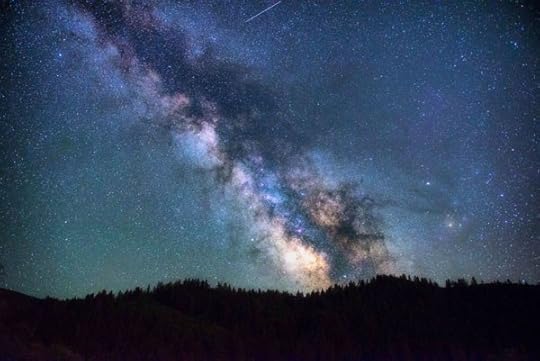
Figure 13 A Dark Constellation
The post Create Constellations appeared first on The Art of World Building.
October 8, 2018
Other Solar System Planets
Our invented planet is unlikely to be the only one orbiting its sun. This section discusses others within a solar system.
In SF, interstellar travel is virtually a given, whether that’s within a solar system or between systems and galaxies. In fantasy, other planets are seldom mentioned unless there’s an event of some significance like a conjunction of moons, stars, the sun, and planets. This might be an oversight, for magic or other supernatural means could allow characters to move between worlds (and moons). If a magic portal can get people from one place to another, the difference between traversing two sides of a planet and between two planets might be negligible for all we know. It could take tremendous power from a wizard or we can decide the ability has become commonplace. Perhaps magical doorways have been created, the magic imbued within them so that ordinary people can use them, just like a technology. We could similarly have magic-powered spacecraft.
When inventing other planets in a system, we should have rocky planets like Mercury, Venus, Earth, and Mars closer to the sun, and gas giants farther away; temperatures are too high for gas planets to form close to the sun. Saturn isn’t the only planet in our system that has rings; they are just more pronounced, so don’t be afraid to do this.
There’s a habitable zone that’s not too far from or too close to the sun, where Earth-like life can develop. Only so many planets can fit within this zone, limiting the number of habitable planets. With a yellow star like ours, this is two to three planets. With a red dwarf sun, scientists concluded that a maximum of five could occur, and closer to the sun, because a red star is cooler. With trillions, not billions, of years for life to develop, life might flourish on more than one world. Life would likely be quite different from Earth, however. Decide if you need more than one habitable world.
Determine how many planets are in your solar system, their names, order, type (rock, gas, ice), and impact, if any, on your world. Some will be visible to the naked eye, though this depends partly on luminosity, a measure of reflectivity of the sun’s light. These planets can be mentioned for added realism, making our main world seem less like an island. Planets are rarely visible; significance is often added to their appearance, particularly in less advanced worlds.
The post Other Solar System Planets appeared first on The Art of World Building.
October 4, 2018
What Causes Hours in a Day
The section talks about what causes the number of hours in a day and how that is changing over time.
The post What Causes Hours in a Day appeared first on The Art of World Building.





